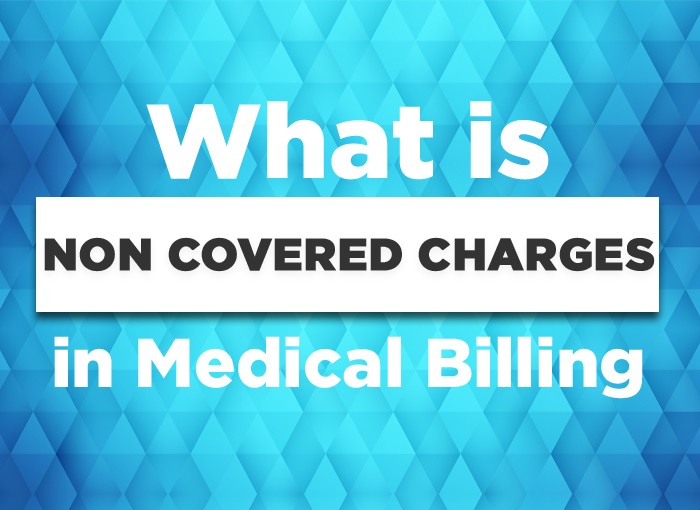What are Non-covered Charges in Medical Billing
At times healthcare providers present bills to the insurance companies for those medical services enjoyed by the patient but not covered by that particular insurance scheme. This could perhaps be due to the notion or ignorance regarding the particular services covered under the patient’s insurance. Thus, the insurance companies will deny such claims against services that demonstrate coverage. This is in the meaning of such billing errors affecting the workflow, as well as delayed payments, and the addition of administrative work. Thus, it is very important to have a very accurate appreciation of non-covered charges by healthcare providers and billing professionals to cut claim denial, maximizing overall billing accuracy.
Understanding Non-Covered Charges
In medical billing, non-covered charges are amounts charged for services that are not covered under Medicare or any other insurance provider. Exclusions are determined by:
- The nature of the insurance plan and terms of the patient’s policy
- The nature of the medical service
- Whether it was medically necessary according to the insurer.
A non-covered charge usually arises when it is deemed elective, cosmetic, experimental, or not aligned with the terms of the guidelines set by the respective insurer. The provider and the patient have to incur additional processing efforts at this stage due to the denial of the claim upon submission.
Impact on Healthcare Providers and Patients
Healthcare providers must be particularly vigilant about non-covered charges as they can:
- Lead to claim denials and delayed payments
- Create administrative burden through appeal processes
- Affect patient satisfaction and trust
- Result in unexpected out-of-pocket expenses for patients
- Impact the provider’s revenue cycle management
Understanding Medicare Non-covered Charges
The Medicare program divides non-covered charges for items and services into four categories (along with a few exceptions):
- Medically unreasonable and unnecessary services and supplies
- Non-covered items and services
- Services and supplies are denied as bundled or included in the basic allowance of another service.
- Items and services reimbursable by other organizations or furnished without charge
(https://www.cms.gov/outreach-and-education/medicare-learning-network-mln/mlnproducts/downloads/items-and-services-not-covered-under-medicare-booklet-icn906765.pdf)
According to Centers for Medicare and Medicaid Services (CMS), “every item or service furnished directly or indirectly by an individual or entity excluded by the Office of Inspector General from participating in all Federal health care programs is a noncovered item or service under Section 1862(e) of the Social Security Act.”
Among these four categories, medically unreasonable and unnecessary services and supplies, and non-covered items and services play a major role in providers’ medical billing practice.
Medically unreasonable, unnecessary services and supplies.
- Services that could have been furnished in a lower-cost setting like the beneficiary’s home or a nursing home
- Exceeding length-of-stay limitations
- E/M services exceeding those considered medically reasonable and necessary
- Excessive therapy or diagnostic procedures
- Unrelated screening tests, examinations, and therapies
- Unnecessary services based on the diagnosis like acupuncture and transcendental meditation
- A beneficiary is paying for items- and services relating to assisted suicide.
- The exceptional circumstances would be subsequent care management, chronic care management, or advance care planning.
The provider would have services that must meet criteria defined by National Coverage Determinations (NCDs) and Local Coverage Determinations (LCDs), plus the services have to reflect the specific physical sign or symptom expressed by the beneficiary.
Non-covered Items and Services Categories
Non-covered items and services are divided into the following categories:
1. Custodial Care
- Includes long-term care services and supports
- Daily living assistance does not require skilled medical care
- Non-medical assistance with activities of daily living
2. Services Outside the United States
- Generally not covered except in specific emergencies
- May be covered in certain border regions
- Special rules apply for cruise ship medical services
3. Personal Comfort Items and Services
- Private room charges unless medically necessary
- Television and telephone services
- Personal hygiene items
- Beauty and barber services
4. Routine Services and Preventive Care
- Certain eye examinations, eyeglasses, and lenses
- Hearing aids and examinations
- Specific immunizations (unless covered under Part B)
- Routine physical checkups (with some exceptions)
5. Cosmetic Surgery
Procedures performed solely for aesthetic purposes
Exceptions for:
- Accidental injury repair
- Improvement of malformed body parts
- Breast reconstruction after mastectomy
6. Services by Immediate Relatives
- Services provided by family members
- Care from household members
- Exceptions for emergency situations
7. Dental Services
Routine dental care
Dentures
Exceptions for:
- Jaw reconstruction
- Dental procedures integral to medical procedures
- Emergency dental procedures
8. Investigational Devices
- Experimental medical devices
- Clinical trial devices not approved by the FDA
- Research-phase medical equipment
Best Practices for Handling Non-covered Charges
Healthcare providers should:
1. Verify Coverage Before Service
- Check patient benefits before providing service
- Obtain prior authorization when required
- Document all verification efforts
2. Communicate with Patients
- Inform patients about non-covered services
- Provide cost estimates
- Obtain Advanced Beneficiary Notice (ABN) when appropriate
3. Maintain Proper Documentation
- Keep detailed medical necessity documentation
- Document patient consent for non-covered services
- Maintain records of coverage verification
4. Implement Prevention Strategies
- Regular staff training on coverage policies
- Updated charge master maintenance
- Routine audit of billing practices
Conclusion
Being aware of the non-covered charges is vital for healthcare providers to have effective billing systems and to ensure reimbursement. Coverage policies, proper documentation, and preventive actions minimize claims denial and improve the revenue cycle management of a provider while providing transparent care to patients.




